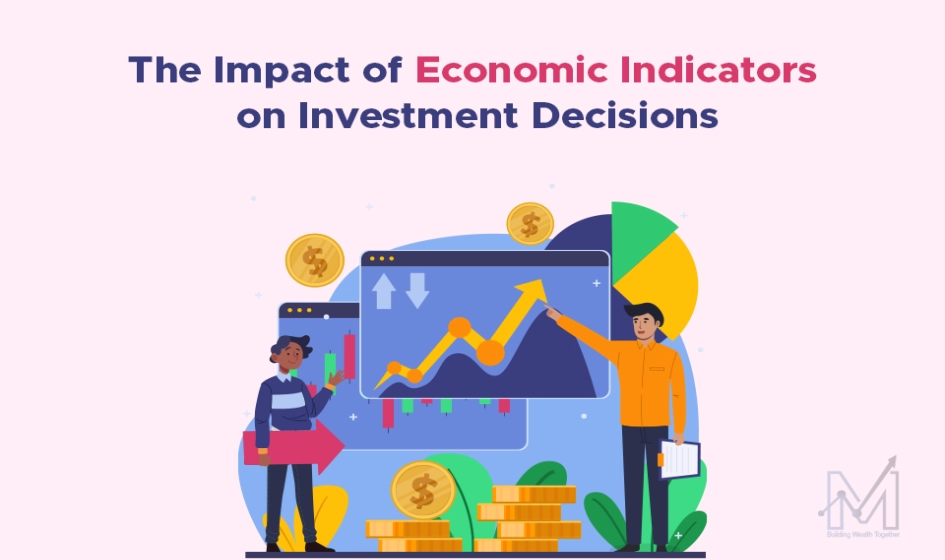
- by admin
- 06 August, 2024
Economic indicators are vital tools for investors, providing insights into the health of the economy and influencing investment decisions. By analyzing these indicators, investors can gain a better understanding of market trends, economic cycles, and potential opportunities or risks. Here’s a guide to how economic indicators impact investment decisions and what you need to know to make informed choices.
Key Economic Indicators and Their Impact
1. Gross Domestic Product (GDP)
What It Is: GDP measures the total value of all goods and services produced in a country over a specific period. It is a key indicator of economic health.
Impact on Investments:
- Growth Periods: Rising GDP typically signals a growing economy, which can boost corporate earnings and stock prices. Investors might look for opportunities in growth stocks or cyclical sectors that benefit from economic expansion.
- Recession Periods: Declining GDP may indicate a contracting economy, leading to lower corporate profits and potentially falling stock prices. Defensive stocks, bonds, or other safe-haven investments may become more attractive.
2. Unemployment Rate
What It Is: The unemployment rate measures the percentage of the labor force that is unemployed and actively seeking work.
Impact on Investments:
- Low Unemployment: Generally indicates a strong economy with robust consumer spending, which can positively impact corporate profits and stock prices.
- High Unemployment: Can signal economic distress and reduced consumer spending. Investors might consider shifting to more stable investments or sectors that are less sensitive to economic cycles.
3. Consumer Price Index (CPI)
What It Is: CPI measures changes in the price level of a basket of consumer goods and services, reflecting inflation or deflation.
Impact on Investments:
- High Inflation: Rising CPI indicates inflation, which can erode purchasing power and increase interest rates. Investors may turn to assets like commodities, real estate, or inflation-protected securities to hedge against inflation.
- Low Inflation or Deflation: Low CPI suggests stable or falling prices, which can be beneficial for consumers and fixed-income investments. However, deflation might signal weak economic demand.
4. Interest Rates
What They Are: Set by a country’s central bank, interest rates influence borrowing costs and economic activity.
Impact on Investments:
- Rising Interest Rates: Higher rates can increase borrowing costs for companies and consumers, potentially slowing economic growth and impacting stock prices. Investors may prefer bonds or other fixed-income securities, which might offer higher returns in a rising rate environment.
- Falling Interest Rates: Lower rates typically reduce borrowing costs, stimulate economic activity, and can lead to higher stock prices. However, investors might face lower returns on bonds and fixed-income investments.
5. Retail Sales
What It Is: Retail sales measure the total sales of goods and services by retailers. It reflects consumer spending and economic activity.
Impact on Investments:
- Rising Retail Sales: Indicates strong consumer spending and economic growth. Investors may consider investing in consumer discretionary stocks or sectors that benefit from higher consumer expenditure.
- Declining Retail Sales: Suggests weaker consumer spending, which can impact corporate earnings. Defensive stocks or bonds might be preferred during periods of declining sales.
6. Business Confidence Index
What It Is: Measures the optimism or pessimism of businesses regarding economic conditions and future business prospects.
Impact on Investments:
- High Confidence: Generally reflects positive economic expectations and can lead to increased investment and expansion, benefiting stock markets.
- Low Confidence: May indicate economic uncertainty or potential slowdowns. Investors might look to safer investments or sectors with less exposure to economic fluctuations.
7. Housing Market Data
What It Is: Includes metrics such as housing starts, building permits, and home prices, reflecting the health of the real estate sector.
Impact on Investments:
- Strong Housing Market: Rising home prices and construction activity can signal economic strength and increased consumer wealth. Real estate investments or housing-related stocks might be attractive.
- Weak Housing Market: Declining home prices and reduced construction activity might suggest economic weakness. Investors could consider shifting to sectors less dependent on housing.
Using Economic Indicators in Investment Decisions
- Analyze Trends: Look at historical trends and current data to gauge the economic environment. Understanding trends helps anticipate future market movements and adjust your investment strategy accordingly.
- Diversify Investments: Use economic indicators to inform your asset allocation. For example, during economic expansion, you might favor growth stocks, while during downturns, you could shift to bonds or defensive sectors.
- Combine Indicators: No single indicator provides a complete picture. Combine multiple indicators to get a holistic view of the economy and make more informed decisions.
- Monitor Global Events: Economic indicators should be considered in the context of global economic conditions and geopolitical events, which can also influence investment outcomes.
Conclusion
Economic indicators are crucial for understanding market conditions and making informed investment decisions. By analyzing GDP, unemployment rates, CPI, interest rates, retail sales, business confidence, and housing market data, investors can gain insights into economic health and adjust their investment strategies. Using these indicators in combination with other analysis methods will help you navigate market fluctuations and make better investment choices.